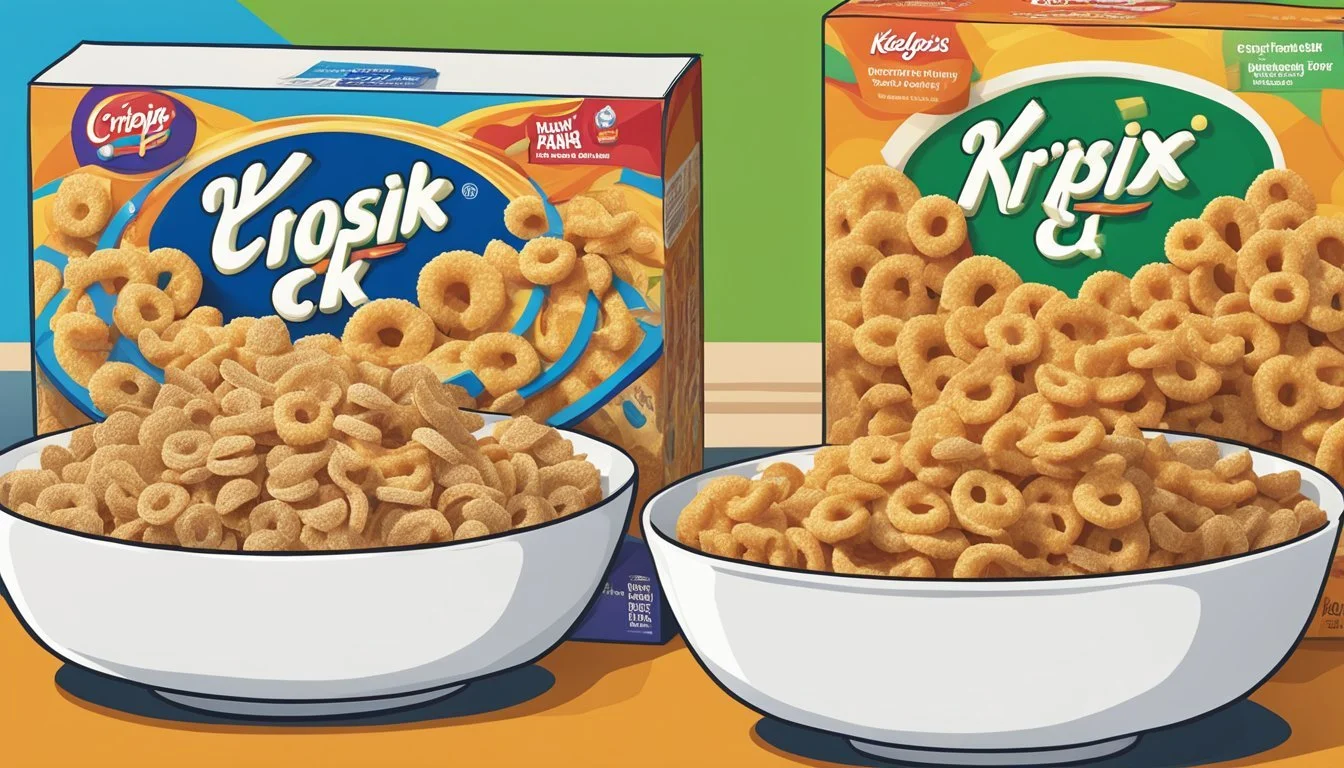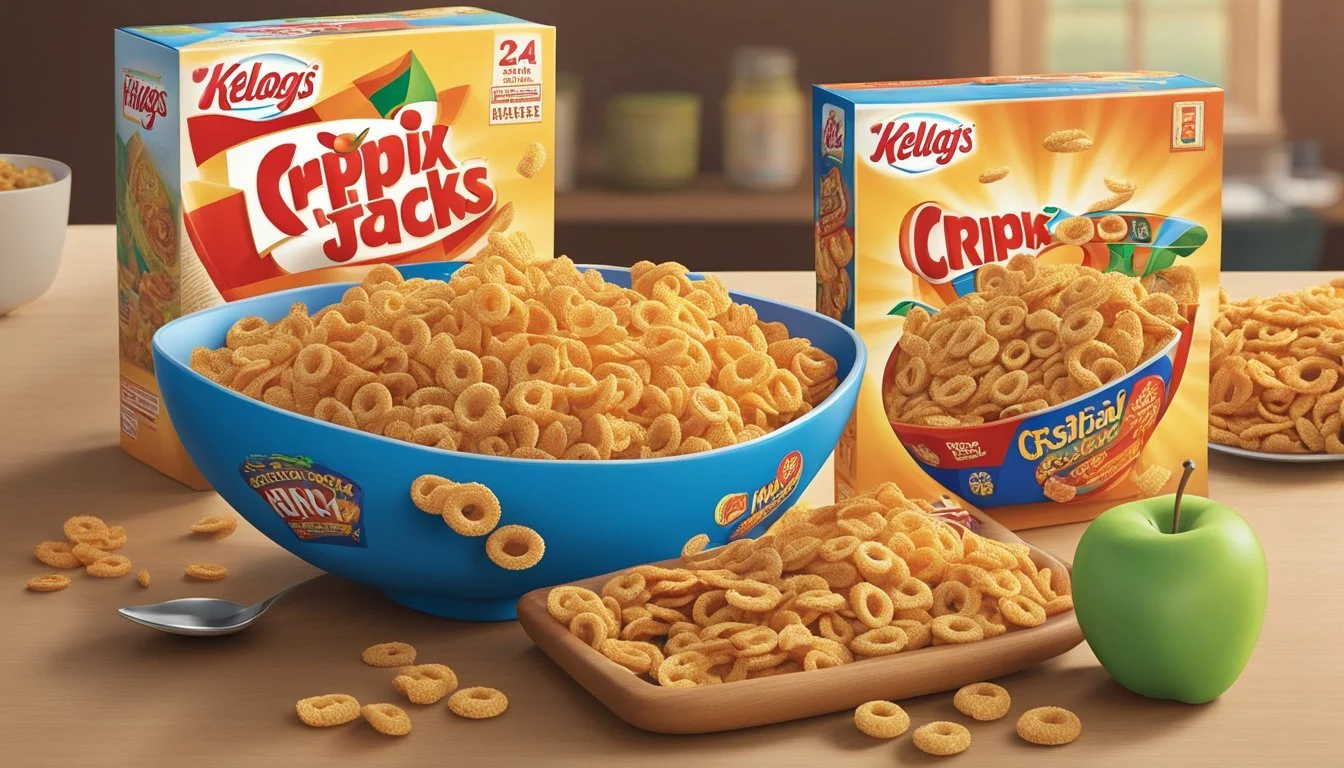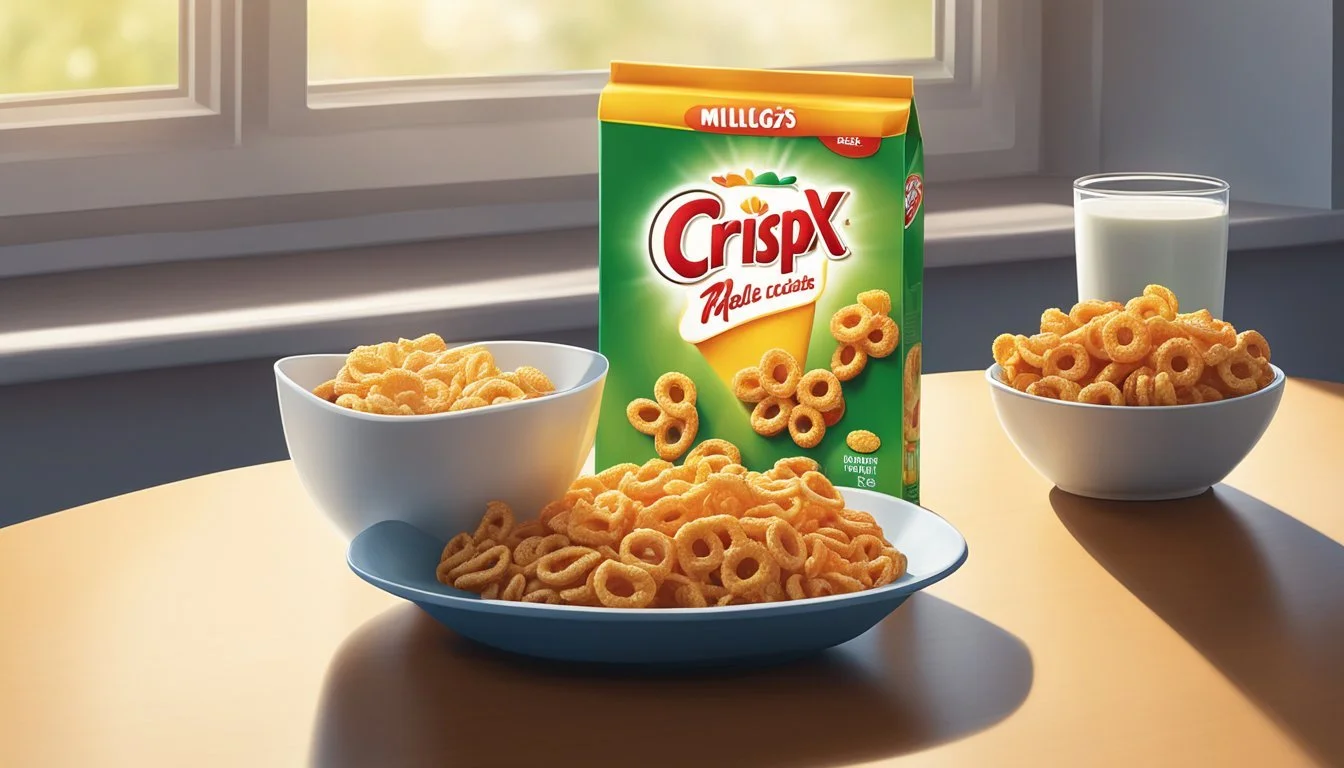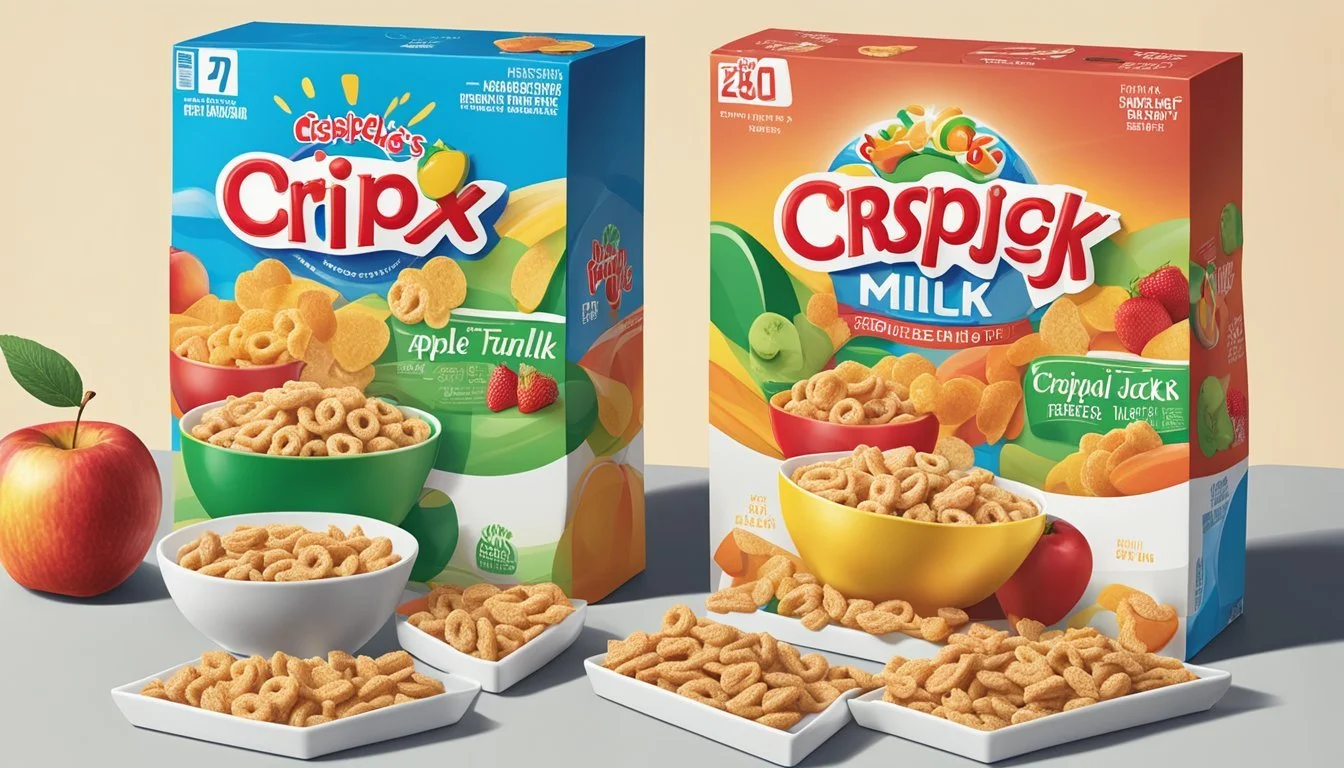Crispix vs Kellogg's Apple Jacks
A Comprehensive Cereal Comparison
This Article is Part of Our Breakfast Cereal Guide with Details on Crispix Nutrition and Kellogg's Apple Jacks Nutrition
Breakfast cereals hold a special place in many households, offering options that cater to a variety of taste preferences and nutritional needs. When it comes to Kellogg's Crispix and Kellogg's Apple Jacks, consumers often find themselves weighing the differences and benefits of each. Crispix stands out for its higher content of essential vitamins and minerals, such as Folate, Iron, and Vitamin B6, which can contribute significantly to a balanced diet.
Apple Jacks, on the other hand, is known for its appealing taste as well as its higher Vitamin C and fiber content. Introduced in 1965, Apple Jacks remains a beloved cereal despite its relatively higher sugar content. For those who prioritize a fortified breakfast with fewer calories, Crispix might be the wiser choice.
Understanding these nuances can help consumers make more informed decisions based on their nutritional preferences and taste. Dive deeper into the distinct characteristics and benefits of these two popular cereals.
History and Brand Overview
Crispix and Apple Jacks are two of Kellogg’s popular cereals, each with distinct origins and developmental milestones. They highlight the innovation and marketing strategies of the Kellogg brand over decades.
Origins of Crispix
Crispix was created by Kellogg's in 1983. It was released to directly compete with Ralston Purina's Chex cereal, which dominated the market with around $125 million in annual sales.
Kellogg's designed Crispix with a unique composition: crispy rice on one side and crunchy corn on the other. This novelty contributed to Crispix gaining significant popularity.
By 1987, Crispix had earned about $65 million in sales. Its success highlighted Kellogg’s ability to penetrate competitive markets with innovative products.
The Emergence of Apple Jacks
Apple Jacks originated in 1965, invented by Kellogg's college intern William Thilly. Initially marketed as "Apple O's", it was later rebranded to Apple Jacks in 1971.
Apple Jacks stood out with its unique blend of apple and cinnamon flavors, paired with a vibrant orange and green color scheme. This cereal became a breakfast table favorite, appealing to children and adults alike.
Over the decades, Apple Jacks featured various mascots and underwent branding changes, solidifying its position in the market.
Kellogg's Brand Evolution
Kellogg's, founded in 1906, evolved into a global brand known for its wide range of breakfast cereals. The introduction of staples like Crispix and Apple Jacks demonstrates Kellogg’s continual commitment to innovation.
Crispix's unique dual-sided design and Apple Jacks' distinct flavor profiles reflect Kellogg's strategic product development.
Kellogg’s also adapted its marketing strategies, leveraging mascots and engaging advertising campaigns. The brand’s ability to capture consumer interest and adapt to market trends has cemented its leadership in the cereal industry.
Nutritional Profile
Comparing the nutritional profiles of Kellogg's Crispix and Apple Jacks reveals notable differences in vitamin, mineral content, and macronutrients. Each cereal offers unique benefits and certain limitations that could influence dietary choices.
Vitamin Content
Crispix and Apple Jacks both offer substantial vitamin content but vary in specific vitamins. Crispix is particularly rich in vitamin B6, providing essential support for brain health and metabolism.
Apple Jacks, on the other hand, excel with higher amounts of Vitamin C, which supports the immune system. Additionally, Apple Jacks contain more vitamin A, promoting healthy vision and skin. Both cereals include vitamin B12 which is crucial for nerve function and red blood cell formation.
Mineral Content
Crispix has a significant advantage in selenium, offering 12.4µg per serving compared to Apple Jacks' 5.6µg. Selenium is essential for DNA production and thyroid function. Apple Jacks excel in calcium, covering daily needs more effectively, with a notable amount of 12mg compared to Crispix.
Apple Jacks contain a higher level of sodium, which is important to monitor for those on sodium-restricted diets. Zinc content is also more prominent in Apple Jacks, beneficial for the immune system and metabolic function.
Macronutrients and Calories
When examining calories, Apple Jacks contain about 110 calories per serving, which is relatively low and suitable for those monitoring caloric intake. Both cereals have moderate amounts of carbohydrates, with Crispix focusing on rice and corn, providing a crisp texture.
Crispix have fewer sugars compared to Apple Jacks, making them a better choice for individuals seeking to reduce sugar intake. Apple Jacks include a higher sugar content, contributing to the cereal's sweetness and appeal, especially for children. Fiber content is modest in both, aiding in digestion.
Each cereal includes protein, aiding in muscle repair and overall body function, with differences in quantity that should be noted by consumers aiming to increase their protein intake through breakfast cereals.
Ingredients and Taste Profile
Crispix and Apple Jacks offer distinct flavors and ingredient lists. Crispix is known for its simplicity and nutritional content, while Apple Jacks brings a blend of apple and cinnamon for a playful morning treat.
Key Ingredients
Crispix features a mix of corn and rice, offering a light, crispy texture. Its ingredients typically include:
Corn
Rice
Salt
Sugar
Malt flavor
Vitamins and minerals, such as folate, iron, and vitamins B1, B2, B6, and B12
Apple Jacks combines grains with a distinctive apple and cinnamon flavor profile. The primary ingredients comprise:
Corn flour blend (whole grain yellow corn flour, degerminated yellow corn flour)
Sugar
Wheat flour
Whole grain oat flour
Modified food starch
Dried apples and apple juice concentrate
Cinnamon
Oat fiber
Vegetable oil (hydrogenated coconut, soybean, and/or cottonseed)
Vitamins and minerals, including vitamin C and fiber
Taste and Texture
Crispix offers a mild, slightly sweet taste with a notable crispy texture, thanks to the combination of corn and rice. When eaten with milk, the cereal maintains its crispness longer compared to many other cereals.
Apple Jacks provides a bright, sweet flavor attributed to the apple and brown sugar blend. The addition of cinnamon offers a spicy undertone. The cereal pieces are crunchy, and when soaked in milk, they still retain a significant portion of their texture while releasing even more of their apple-cinnamon taste.
Overall, the taste experiences are tailored to different preferences: Crispix for those favoring a less sweet, more straightforward crunch, and Apple Jacks for enthusiasts of a fun, fruity-spiced breakfast cereal.
Dietary Considerations
When comparing Kellogg's Crispix and Apple Jacks, specific dietary aspects such as fat content, carbohydrate and sugar levels, and gluten content must be considered. Here’s a deeper look into how these cereals meet various dietary needs.
Cereals in Low-Fat Diets
Crispix and Apple Jacks both contain relatively low levels of fats. Crispix cereal offers an advantage with its lower overall fat content, including saturated fats:
Crispix has approximately 0.5 grams of total fat, with negligible saturated fat.
Apple Jacks contains slightly more fat, approximately 1.5 grams, with about 0.5 grams being saturated fat.
For those adhering to a low-fat diet, Crispix may be the preferable choice as it minimizes fat intake more effectively.
Cereals in Low-Carb and Low-Sugar Diets
Individuals following low-carbohydrate or low-sugar diets will find significant differences between the two cereals:
Crispix: Generally lower in sugars, with around 3 grams per serving and approximately 24 grams of total carbohydrates.
Apple Jacks: Higher in sugar content at 14 grams per serving and 34 grams of total carbohydrates.
For those focusing on low-carb or low-sugar diets, Crispix offers a lower carbohydrate and sugar option, making it more suitable. Additionally, Crispix would contribute less to overall glycemic load, important for managing blood sugar levels.
Gluten Content and Alternatives
Both Crispix and Apple Jacks contain ingredients derived from grains, but specific gluten content should be noted:
Crispix: Made primarily from corn and rice, naturally gluten-free grains; however, cross-contamination in manufacturing may occur.
Apple Jacks: Contains wheat flour, which means it is not suitable for those with gluten intolerance or celiac disease.
For those requiring gluten-free options, Crispix might be a better choice, provided confirmation that there has been no cross-contamination. It's crucial for consumers with gluten sensitivities to verify this information on packaging or consult with the manufacturer directly.
Comparison with Other Cereals
This section will compare Kellogg's Crispix and Apple Jacks with other popular cereals like Froot Loops, Cocoa Pebbles, and Chex varieties. It will highlight differences in vitamins, minerals, and macronutrients to offer readers a clear understanding of their nutritional profiles.
Crispix Versus Froot Loops
Crispix and Froot Loops are both popular cereals from Kellogg's, but they have distinct nutritional profiles. Crispix is known for being low in sugar and high in essential vitamins such as B1, B2, and B6. It also offers double the Selenium content compared to Apple Jacks.
Froot Loops, a colorful and sweet cereal, often appeals to children. Nutritionally, Froot Loops contain higher sugar levels and artificial coloring. In terms of vitamins, Froot Loops are fortified with Vitamin C, making them a bit different. Crispix, on the other hand, focuses more on essential B vitamins and minerals.
Apple Jacks Against Cocoa Pebbles
When comparing Apple Jacks to Cocoa Pebbles, the key differences lie in their flavor profiles and nutritional benefits. Apple Jacks, with its apple and cinnamon flavor, contains more fiber and Vitamin C. This adds to its appeal as it provides a modest amount of these nutrients.
Cocoa Pebbles, made by Post Consumer Brands, are chocolate-flavored and generally contain higher sugar levels. Cocoa Pebbles are less rich in vitamins and minerals but offer a strong taste that many chocolate lovers appreciate. Both cereals have around 110 calories per serving but differ significantly in sugar content and nutritional enhancements.
Nutritional Differences with Chex Varieties
Chex cereals, produced by General Mills, come in various types including Rice Chex, Corn Chex, and Wheat Chex. These varieties present different nutritional profiles compared to Crispix and Apple Jacks. Rice Chex, for instance, is gluten-free and has a lower sugar content, making it suitable for those with specific dietary needs.
Corn Chex offers high levels of essential vitamins and minerals similar to Crispix but lacks the flavor variety found in Apple Jacks. Wheat Chex provides more fiber and protein, making it a good choice for those seeking a more filling breakfast option. In comparison, Crispix strikes a balance with its dual corn and rice composition, while Apple Jacks stands out with its unique flavor and added Vitamin C.
Packaging and Serving Suggestions
Both Crispix and Apple Jacks offer distinct packaging designs and serving recommendations that cater to diverse consumer needs. They provide detailed nutritional information and various serving suggestions which can enhance the overall breakfast experience.
Box Design and Information
Crispix cereal boxes typically feature a blue and yellow color scheme with a clear image of the cereal to attract customers. Nutritional information is prominently displayed on the side, with a breakdown of vitamins, minerals, and ingredients.
Apple Jacks boxes, with their vibrant green and orange colors, often target younger audiences with playful designs and fun characters. Nutritional details, including calories, vitamins, and minerals, are clearly listed. Both cereals utilize SmartLabel technology, offering easy access to detailed product information via smartphones.
Serving Size and Pairings
A standard serving size for Crispix is 1 cup (about 29 grams), providing 110 calories, enriched with vitamins and minerals. It's often enjoyed with milk, boosting its nutrient content. Crispix pairs well with fresh fruit such as bananas or berries for added flavor and nutrition.
Apple Jacks also has a serving size of 1 cup (about 27 grams), with 100 calories. It pairs nicely with milk and can be enhanced with slices of apple or other fruits. Both cereals maintain a balance of taste and nutritional value suitable for various dietary preferences and breakfast options.
Market Presence and Consumer Choice
When it comes to breakfast cereals, Kellogg's Crispix and Kellogg's Apple Jacks command significant presence on the shelves. Both cereals offer unique tastes that cater to different consumer preferences.
Crispix is often chosen by those looking for a healthier option. It provides essential vitamins such as Folate and Iron and is lower in calories compared to many other cereals. The cereal's light and crispy texture adds to its appeal.
On the other hand, Apple Jacks is favored for its fun and sweet flavor. It adds excitement to the breakfast table, especially for children. It also contains Vitamin C and fiber, which add to its nutritional profile.
Sales data highlights:
The average unit price for Kellogg's cereals is $3.47, making them affordable options for many families.
Marketing efforts are evenly distributed, although snacks are experiencing faster growth in recent years.
Comparative Nutritional Value:
Nutrient Crispix Apple Jacks Folate High Lower Iron High Lower Vitamin B6 More Less Fiber Less More Vitamin C Lower Higher
Consumers' choice between the two cereals often depends on whether they prioritize health benefits or a flavorful, fun breakfast experience. Crispix attracts those focused on a nutritious start to their day. Meanwhile, Apple Jacks appeals to those who enjoy a sweeter taste and a playful eating experience.
Cultural and Media Impact
The impact of Kellogg's Apple Jacks and Crispix on culture and media is largely driven by how they are marketed and their roles in breakfast routines. Examining the mascots and advertising campaigns reveals the strategies behind their popularity, while understanding their presence in breakfast culture highlights their significance over the years.
Cereal Mascots and Advertising
Kellogg's Apple Jacks is well-known for its vibrant mascots, particularly Apple and CinnaMon. These characters, embodying an apple and a cinnamon stick respectively, playfully compete and team up in commercials, attracting the attention of children and families. Their antics are designed to emphasize the flavors and fun of Apple Jacks, making the cereal memorable and enjoyable.
Crispix, in contrast, has not been as heavily marketed with mascots. Instead, its advertising focuses on the unique duality of the cereal's crispy corn and rice sides. This straightforward approach aims to appeal to consumers looking for a crunchy, less sugary breakfast option. Both cereals use targeted advertising that resonates with their different audiences, from fun-loving kids to health-conscious adults.
Impact on Breakfast Culture
Apple Jacks has become a staple in American breakfast culture since its debut in 1965. Its colorful cereal pieces, accompanied by a sweet, cinnamon taste, make it a favorite among children. The cereal's distinct flavor profile and engaging mascots have helped it maintain popularity over the decades, even spreading to markets outside the U.S., including Australia.
Crispix, introduced in 1983, caters more to those seeking a nutritious start to their day. Known for its high folate, iron, and various B vitamins content, Crispix appeals to individuals interested in a balanced breakfast. It has carved out a niche among cereals that offer both taste and nutritional benefits, contributing to its steady presence in the breakfast food aisle.
Both cereals have significant roles in shaping breakfast habits and preferences, reflecting broader trends in nutrition and marketing within the cereal industry.
Environmental and Ethical Considerations
Kellogg's is committed to sustainable production and maintains a strong ethical code. These principles extend to the manufacture of both Crispix and Apple Jacks.
Sustainable Production Practices
Kellogg's has implemented various green initiatives to curtail environmental impact. Since 2015, they have significantly reduced greenhouse gas emissions by nearly 13% across European manufacturing sites. Manchester, UK, specifically saw a 26% emissions reduction and 8% less energy use.
Their push towards sustainability involves cutting packaging waste. Brands like Bran Flakes, Special K, and Frosties have led this initiative, reducing 191 tonnes of packaging annually. This commitment to environmentally-friendly practices underscores the importance the company places on green production processes.
Nutritional Responsibility
Kellogg’s ethical approaches extend to nutritional aspects, ensuring their products meet high standards. Crispix offers more essential vitamins and minerals compared to Apple Jacks. It contains higher amounts of Folate, Iron, Vitamin B1, B2, B3, B6, and B12, along with Selenium.
Apple Jacks, although less nutrient-dense, provides more Vitamin C and Fiber. Kellogg’s aims to cater to diverse nutritional needs while adhering to ethical standards. Each cereal has its own beneficial nutritional contributions, reflecting Kellogg’s responsibility toward consumer health.
More on Crispix
More on Kellogg's Apple Jacks
Cinnamon Toast Crunch vs Kellogg's Apple Jacks: Which is better?
French Toast Crunch vs Kellogg's Apple Jacks: Which is better?
Honey Nut Cheerios vs Kellogg's Apple Jacks: Which is better?
Kellogg's Apple Jacks vs Kellogg's Froot Loops: Which is better?
Kellogg's Apple Jacks vs Post GrapevsNut Flakes: Which is better?
Kellogg's Apple Jacks vs Post Raisin Bran Cereal: Which is better?









